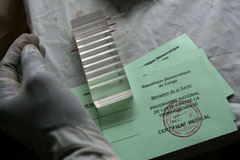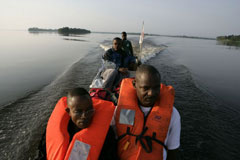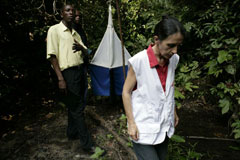Much More R&D Needed to Make the Disease History

In Isangi, Oriental Province, Democratic Republic of Congo, MSF works to assure early diagnosis and treat of trypanosomiasis (sleeping sickness). © Francesco Zizola |
Human African Trypanosomiasis, also known as African Sleeping Sickness, is a fatal and much neglected disease that continues to plague parts of Africa. The drug most commonly used to treat the disease is so toxic that it kills one in 20 patients. While a better drug exists, it is too complex to use in resource-poor settings. In the Democratic Republic of Congo (DRC), sleeping sickness has made a disturbing comeback over the past few decades.
Three years ago, Isidor's village, lost in the remote territory of Isangi in the Eastern province of the Democratic Republic of Congo, was hit by a mysterious disease. Villagers had begun losing sleep at night while being overcome by an irrepressible fatigue during the day. Some would wander incoherently, sometimes becoming violent; others slipped into a deep coma and died. "People became tired, apathetic. They would go to hospital but could not be diagnosed. Superstition replaced medical knowledge and people started thinking it had something to do with their neighbors, child witches and so on. Even the older generation had forgotten the symptoms and thought it was a new disease," Isidor, a patient with MSF, recalls.
Yet the strange illness was in fact not new to the area. Transmitted by the bite of an infected tse tse fly, sleeping sickness, also known as trypanosomiasis, had long plagued the country while it was still a Belgian colony. Faced with waves of epidemics that ravaged entire villages and destroyed its precious workforce, the colonial administration launched huge campaigns to combat the disease. These efforts were largely successful and, by the end of the 1960s, sleeping sickness had been brought under control.

An MSF team travels by motorized longboat to reach the remote area of Isangi affected by trypanosomiasis. © Francesco Zizola |
But years of civil war combined with poor public health management were to ruin health infrastructures and trypanosomiasis came back with a vengeance. When in 2003 MSF set up an exploratory mission in Isangi in conjunction with the DRC's Ministry of Health, they found the area was suffering from an extremely high incidence of the disease.
MSF opened a program in August 2004 to try to bring prevalence rates from an alarming peak of 14 percent to less than 1 percent, largely through an extensive active screening campaign. But in DRC, the most commonly available treatment today has serious drawbacks. The national protocol continues to use melarsoprol, an arsenic derivative that is over 50 years old, for the advanced stage of the disease. Described as "fire in the veins" the drug is injected and excruciatingly painful. Its side effects can be lethal and around five percent of those treated die from complications. In some areas, treatment failure with melarsoprol has greatly increased, reaching up to 30 percent of cases.
A better drug does exist. Eflornithine, dubbed the "resurrection" drug for spectacularly waking patients from a coma, has demonstrated its effectiveness in many of the places where MSF has used it. It is far less toxic than melarsoprol.
But for many countries, including DRC, eflornithine remains extremely difficult to implement. "It requires significant human resources with four infusions per day for fourteen days. You need nurses 24 hours a day. It is a lot of fluid; you need catheters, not to mention the transport of all the materials to often very remote areas. All this represents a cost that national programs are often unable to afford even if they are given the drug for free," explains Els Torreele, project manager for DNDi (Drugs for Neglected Diseases initiative), a product development partnership set up by a number of organizations including MSF. MSF and its partners have raised these issues with WHO and the drug¹s manufacturer, Sanofi-Aventis.

MSF staff set up a tse tse fly trap. © Francesco Zizola |
Current developments do give some reason to be hopeful: on the one hand, MSF is encouraging Sanofi-Aventis and WHO to make "eflornithine kits," that include ready-to-use equipment, available to national programs. A kit is a response to some of the problems that make eflornithine a difficult option for national programs. "We hope that this will convince national programmes to use eflornithine as it will be much easier to implement," explains Unni Karunakara, medical director at MSF's Campaign for Access to Essential Medicines. In a parallel development, MSF and several partner organizations, including DNDi, Epicentre the WHO/TDR, are conducting clinical trials to establish the efficacy of using eflornithine in combination with another drug, nifurtimox. If successful, this simplified protocol will be much easier for national programs to implement, as it only requires two infusions of eflornithine per day for seven days. Another big advantage is that using eflornithine in combination will lessen the danger of resistance developing.
But significantly more research and development will be needed to make sleeping sickness history. "Eflornithine is much better than melarsoprol, but it remains a temporary solution. It also has side effects and remains complicated to administer. What would really make a difference is a simple means of diagnosis and a new drug that is easy to use," points out Torreele.
"What we need to fight trypanosomiasis efficiently is more R&D and subsequent investment by governments, donors and the international community to find a fully effective, easy-to-use and sustainable drug." An ambition that the Kenyan and Brazilian Resolution on R&D discussed at the 2006 World Health Assembly can help make real.



